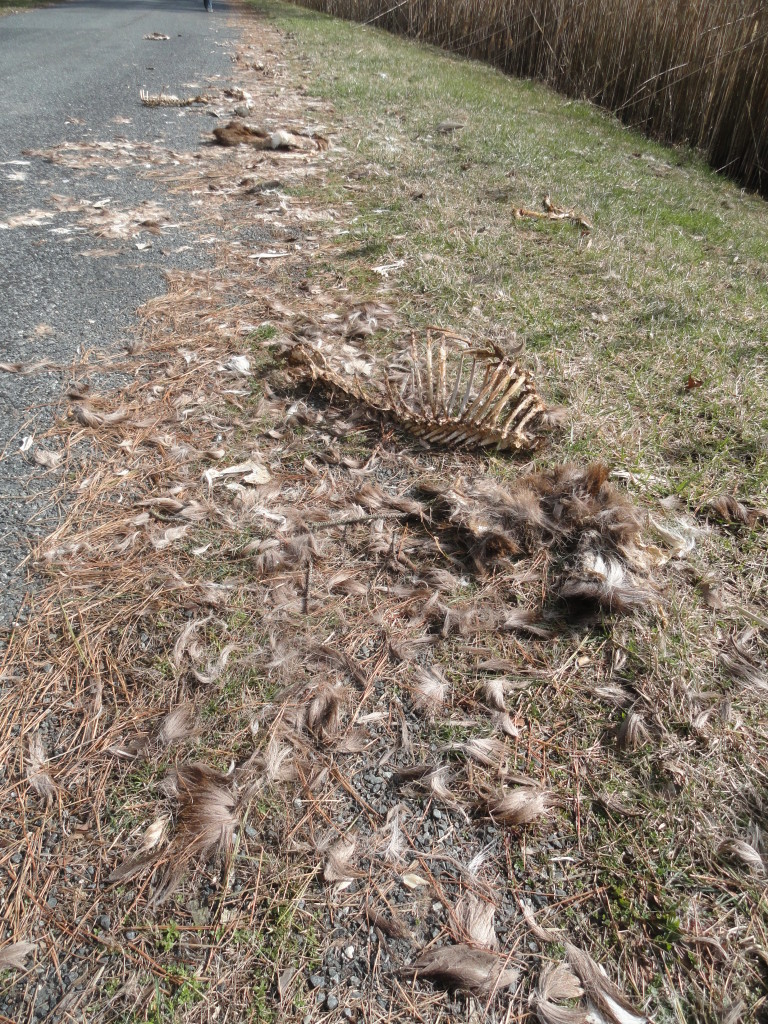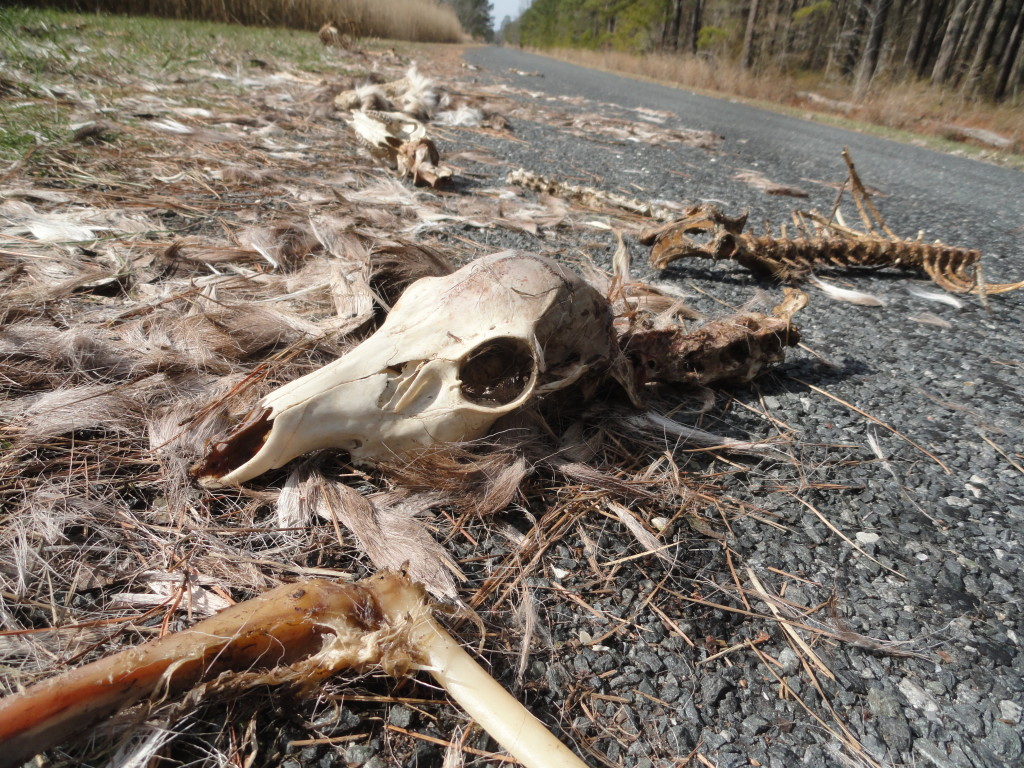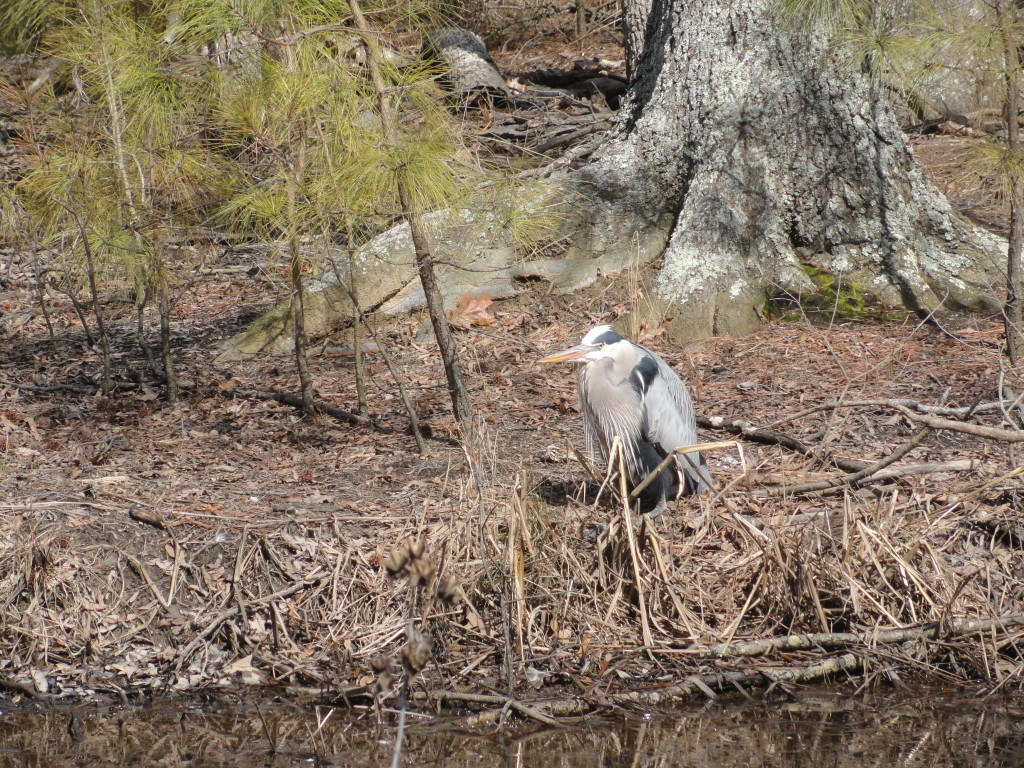Many people have probably enjoyed wildlife drive of the Blackwater National Wildlife Refuge. Yesterday I discovered a desolate part of the refuge that will forever be imprinted on my mind as “Skeleton Road.”
While wildlife drive is the main visitor area, the refuge actually covers a much larger expanse, much of which is rarely visited. Rather than turn onto Key Wallace Drive off the road from Cambridge, Maryland, we chose to continue driving south along Rte 335 in an effort to reach the southern borders of the refuge. A few twists and turns and then suddenly an unmarked road beckons a bit of daring. In retrospect, perhaps we should have turned around when we saw the skeletons.

A half dozen or so vultures gathered on the road ahead, hesitatingly flying off at the last second as our car approached. Soon we were in the midst of a slew of skeletons and fur, splayed on both sides of the road as if a sirocco (or a blender) had been turned on a passing herd. Most of the bones had been picked clean, though several rib cages and lower limbs stood nearly intact. Most of the remains were clearly deer, but there were other animal parts as well. Why here? I never did figure out an answer.

Traveling further along it became evident that the houses, for lack of a better word, were also largely skeletal. Abandoned, or in need of being abandoned, the houses likely were the home of squatters – some human, some animal. Some were clearly inhabited, though one wonders how the crumbling infrastructures and naturally skylighted roofs held up to the occasional thunderstorm. Banjo riffs from Deliverance involuntarily sprang to mind. Eventually the paved road became a dirt road, deeply potholed and muddy from many long cold winters, and then, abruptly, and perhaps appropriately, dead ended.
Surprisingly the vultures hadn’t returned to the scene of destruction by the time we returned; perhaps they knew we would be back, retracing our path back to the land of the living.
Luckily, when we did eventually get back to the main visitor area of the refuge, we were able to marvel at the majesty of several bald eagles soaring overhead and resting on hillocks in the shallow edges of the central body of the apt-named Blackwater. Along the drive we saw this Great Blue Heron, hunkering down in protection from the icy wind.

The trip also took us to the old National Marine Fisheries Service laboratory (now a cooperative unit with the state of Maryland) in Oxford, and a wine-tasting on St. Michaels. A wonderful day experiencing nature – and Skeleton Road.
David J. Kent is the author of Lincoln: The Man Who Saved America, now available. His previous books include Tesla: The Wizard of Electricity and Edison: The Inventor of the Modern World (both Fall River Press). He has also written two e-books: Nikola Tesla: Renewable Energy Ahead of Its Time and Abraham Lincoln and Nikola Tesla: Connected by Fate.
Check out my Goodreads author page. While you’re at it, “Like” my Facebook author page for more updates!
Follow me by subscribing by email on the home page. Share with your friends using the buttons below.











A sad scene… clear omen that you should turn back… 🙂
I’m glad we didn’t. 🙂
Fascinating! Out here, a deer carcass next to the road generally means there’s a dented (usually badly) car somewhere. Speeding city-slickers notwithstanding… bad water, fermented food, rabid squirrels perhaps?
Definitely not a speeding car on that road so I’m puzzled as to why such a massacre scene. Would vultures pick up entire carcasses from the main road and carry them to this location (about 1/2-3/4 mile away)? Really spooky place that I’m glad I only visited in daylight. I still hear the dueling banjos playing in my head just thinking about it. 🙂
Shared this with my husband… He was puzzled as well, but said they don’t appear to have been poached, though he couldn’t be certain. He suggested botulism, perhaps from a local water source. (Don’t drink the Blackwater?) Apparently it’s an intermittent problem with wild horses out here.
The bad water is possible, though maybe wild dogs. The vultures (and whatever else) had picked most of it clean. Of course, it could have been one of the wild people that I imagine inhabit one or more of those dilapidated buildings I passed, though why they would leave the bones and fur behind I have no idea.
Pingback: Skeletons, Hard Drives, and Galileo – Oh My Edison | Science Traveler